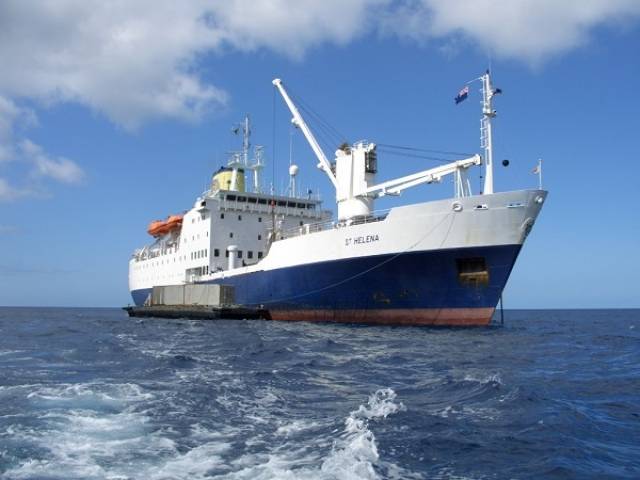#FarewellRMSstHelena - One of the world’s most remote inhabited islands, St. Helena, a British Overseas Territory in the South Atlantic Ocean is to lose its unique historic shipping service with South Africa, the only sea connection with the outside world, writes Jehan Ashmore.
The combined passenger and freight vessel RMS St. Helena is to be replaced by a 'cargo-only ship' as the first airport on the island was due to have opened last month. Until this takes place, the RMS St. Helena operates the deep-sea service from Cape Town. It was more than two decades ago when RMS St. Helena made a notable once-off call to Dublin and Cobh (Cork) in 1995.
Both the RMS St. Helena and Cunard Line's Queen Mary 2 belong to a unique club of only a handful of vessels designated with the Royal Mail Ship (RMS) prefix.The vessel of the St. Helena Line is operated by AW Ship Management.
The QM2 and the much smaller 6,797 tonnes RMS St. Helena have called to Dublin Bay, however unlike the liner, the latter vessel was easily accommodated in Dublin Port. It was during that call that I recall the Scottish custom-built vessel for St. Helena Island, berthed alongside Sir John Rogerson’s Quay.
The RMS St. Helena was then on a cruise on behalf of Swan Hellenic, which saw her return to Scottish waters where in Aberdeen she was launched in 1990. Albeit, the cruise was focused on the other side of Scotland along the Western Isles.
‘RMS’ as she is referred to by the 4,500 population of the islanders known as the ‘Saints’, was set to make her final voyage to St. Helena in July. The reason for closing the combined service is primarily due to the opening of the airport, though a ‘freight-only ship’ will be introduced to maintain services to Jamestown, the capital. The island is famous as this is the place of Napoleon Bonaparte's exile and death.
RMS St. Helena, her 59 crew and 139 passengers (just 20 short of full capacity), yesterday morning completed a special voyage returning to the UK, London (Tilbury Cruise Terminal). Originally, RMS St. Helena, served the ocean-going service from UK ports (Cardiff then Portland) but then switched operations running out of Cape Town, South Africa.
Later this week RMS St. Helena is to head upriver along father Thames to the Pool of London, where the ship's career of more than 25 years is to be commemorated. (Afloat.ie will have more on this historic and last visit to the UK capital).
After a series of events held in London, the final voyage of RMS St. Helena that is from the UK is to depart on 14 July with the following ports of call: Tenerife, Canary Islands, Ascension Island, St Helena then back to Ascension. From this British Overseas Territory (likewise of Tristan da Cunha) RMS St. Helena heads back to her island namesake before eventually making a final leg to Cape Town due mid-July. This was meant to be the final ever voyage, however (as further explained below) an extension of South Africa only based voyages are scheduled to continue to late September.
The distance of the this South Atlantic voyage is 1,950km/1,200 miles and takes five-days, compared to the planned introduction of scheduled flights to and from Johannesburg, taking a mere six hours. As previously mentioned the new airport remains to be opened. According to a St. Helena Government statement this is due to the challenges of wind shear identified by the first few flights into the airport that began with the first historic trial flights in April.
Work to address this issue is underway at the new airport and the SHG recognise there are St Helenian’s in Cape Town, the UK and Ascension who are ready to return to St Helena and do not have a confirmed means of doing so. Others will be planning journeys in the coming weeks.
SHG will honour its commitment to maintain access by extending the service of the RMS St. Helena as an interim measure and for a limited period until air services begin. This service as usual will be for passengers and freight. The revised schedule of the RMS St. Helena can be viewed here, noting bookings will be accepted from today, Monday 6 June.
According to the St. Helena Line website, the last of the extended voyages is that of Voyage 246 (9th-27th September). This involves a round trip from Cape Town to St. Helena with a call to Ascension Island. The final port of call is to Cape Town which is scheduled for 27 September, marking the end of this chapter in the island's maritime history.
The travel situation is been kept under review and should an air access solution be found quickly, the SHG would need to reassess plans for RMS St Helena.
































































